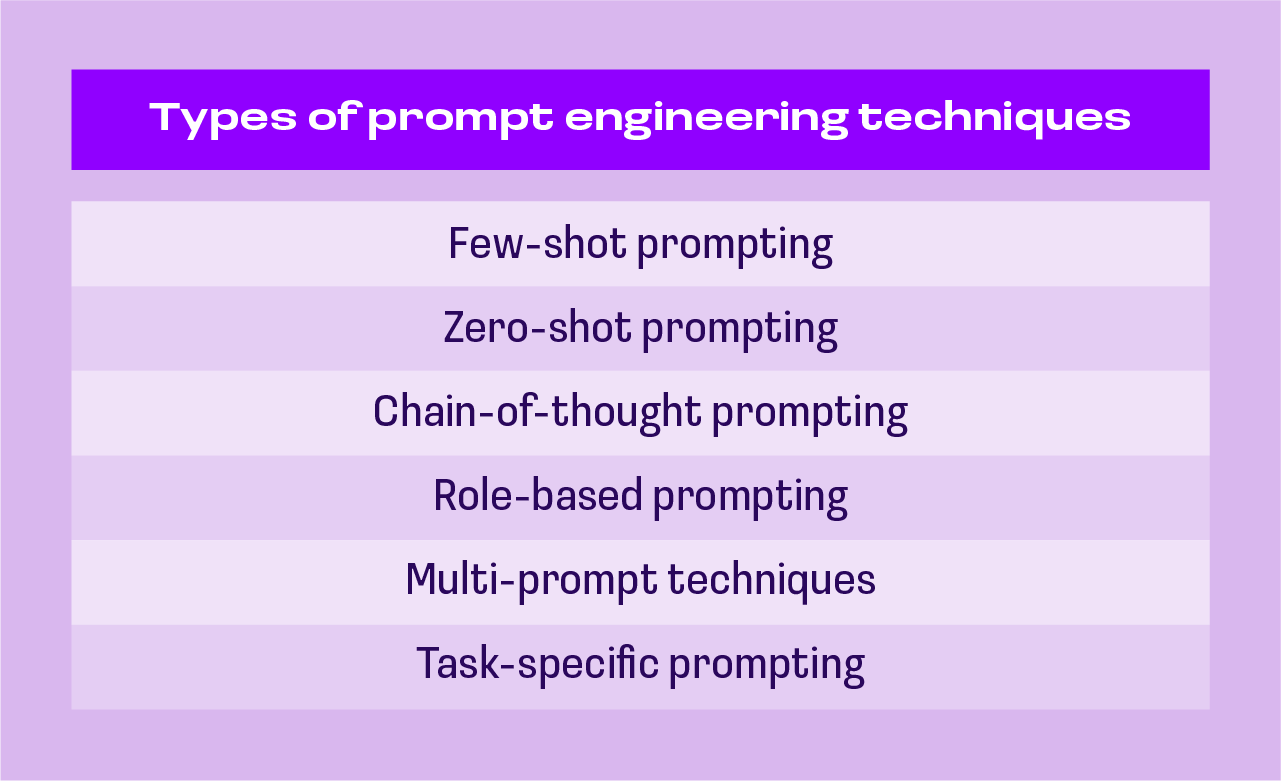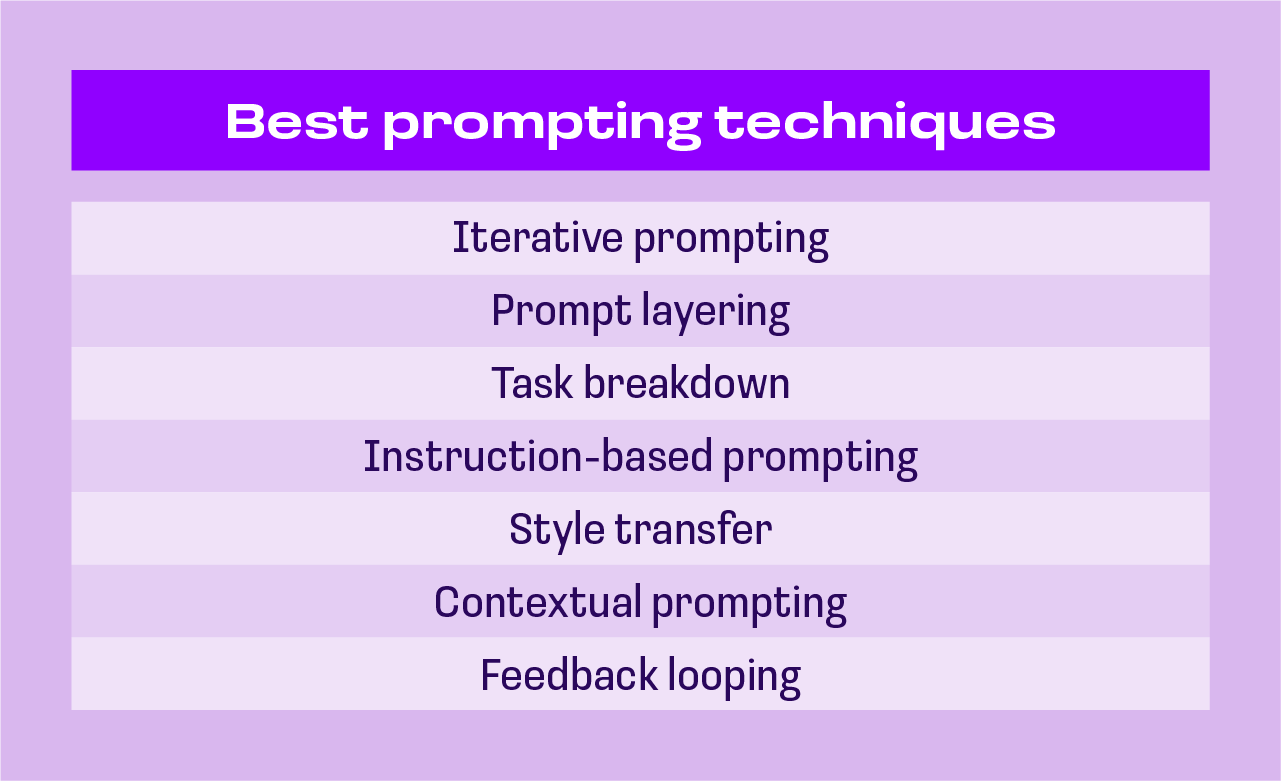Best prompt engineering techniques

Technology continues to reach more and more milestones and how we engage with it is also evolving. One of the most significant innovations has taken place in artificial intelligence (AI) where machines have been taught to learn, think, and communicate just like humans.
Because of how they are created, these advanced chatbots have shown quirks in how they deliver information. Users have realized that they need to ask questions in a very specific way to get useful answers. This is called prompt engineering.
When you’re talking to a machine and ask it to generate a cue or a “prompt,” it will respond with relevant actions or by giving you appropriate information.
Prompt engineering is all about giving instructions or asking large language models (LLMs) and other AI models the right questions, which will result in specific outputs.
This kind of engineering is crucial to anyone, whether they’re an expert seeking to leverage high-level LLMs opportunities or just an enthusiast excited about the trend in AI.
Let’s now discuss the technical aspects of prompt engineering and go over some insights into why it’s vital within the broader AI field.
What is prompt engineering?
Prompt engineering involves giving generative AI instructions to help produce desired results. Although generative AI is designed to be more like humans, it requires precise directions to give relevant, high-quality output.
In prompt engineering, you’ll select the correct signs, words, phrases, and formats that assist AI to interact meaningfully with users.
Prompt engineers use their imagination through trial and error by coming up with a library of input texts to effectively operate an application’s generative AI (GenAI).
What is a prompt?
A prompt is a text in the natural language used to train Gen AI on certain tasks. Gen AI uses large language machine learning models. It creates various pieces of content, such as music, images, videos, conversations, and stories.
AI models are extremely multi-functional and they serve functions like translating from one language to another, answering questions, completing sentences, and summarizing documents based on their training data. However, AI models need better information and context to make meaningful and sound output with minimal errors.
Prompt engineering is also the process of creating and refining prompts to ensure that the AI creates valuable content.
After reinterpretation, prompt engineering ensures that the AI model appropriately responds to a wide range of user input. This could ultimately lead to enhanced customer experience.
Why is prompt engineering important?
AI advancements have significantly increased the number of prompt engineering jobs. Prompt engineers bridge the gap between LLM and end users. They identify templates and scripts that users can complete or customize to get the best possible results from language models.
Prompt engineers carry out experiments with diverse inputs to create a prompt library that can be used by app developers in different scenarios.
Prompt engineering assists in making AI applications more effective and efficient. Application developers normally add open-ended user input within a prompt before submitting it to the AI model.
For instance, consider weather forecasting AI. A user might ask, “What’s the weather like?” Without context, the question lacks specificity. Internally, the system transforms this into a more detailed prompt, such as, “You are a weather assistant providing accurate forecasts. A user from Chicago, Illinois is asking for today’s weather conditions, including temperature, wind speed, and the chance of rain.”
This enhanced prompt allows the AI to deliver more precise and helpful information.
Elements of AI prompt engineering
Prompt engineering is a generative method of giving AI systems instructions to provide contextually relevant and coherent responses in different applications.
Learning about ChatGPT prompts for coding helps developers control the process of clearly conveying the query or task to be executed by the AI model.
Here are the main elements of AI prompt engineering that work together to enhance AI interactions.
Role
A role describes the position where the prompt assumes an individual which assists the AI in formulating a response that is relevant to that persona.
An example could be, “Travel agent: A customer is asking for recommendations on booking a family vacation to Europe.”
By specifying “travel agent,” the AI generates a response with a professional, travel-oriented tone, offering detailed suggestions and options that are tailored to family-friendly destinations and itineraries.
Questions
A question is a way of requesting more information or answers from the AI in a particular area while restricting its feedback and retaining its focus.
An example is “How does a lack of sleep affect productivity?”
In this case, the question implies that the AI should explain the negative impact of insufficient sleep on a person’s ability to focus, work efficiently, and maintain cognitive function.
Context
Giving the AI additional contextual information helps it adapt its response to the relevant scenario, thus improving the material’s accuracy and relevance.
For example, when given a prompt like “Given the financial data provided below, recommend investment strategies for a conservative investor,” the AI can tailor its response to suggest strategies that align with the investor’s risk tolerance and long-term financial goals, using the provided data as context.
Task/Instruction
An instruction or task refers to a clear outline of what specific response or action the AI should generate.
For instance, “Write a blog post about the advantages of remote work for companies and employees” is a prompt asking the AI to create a blog post that highlights both the business and personal benefits of remote work, steering the response toward a balanced, informative tone suitable for a professional audience.
Example
One effective learning strategy could be adding examples to the prompts, which in addition to setting clear expectations for the desired output, also attracts the AI’s attention.
For instance, the prompt could be, “Given the main argument and conclusion of an essay, develop the body paragraphs with supporting evidence and analysis.”
The AI is supplied with a clear framework and is likely to generate content that aligns with the logical flow and argumentative structure of the provided introduction and conclusion.
Incorporating these elements into prompts allows engineers to communicate the desired task or query to AI models. This leads to more precise, relevant, and context-aware responses, enhancing the overall usability and effectiveness of AI text generation systems across various applications and domains.
As EngX expert, Roman Tehlivets says, it is essential to learn AI prompt engineering techniques now, “it’s essential if you want to adopt/build on top of this technology.”
Types of prompt engineering techniques
There are many techniques of prompt engineering to choose from, depending on your goal. Each method serves a unique purpose. By picking the right one, you can get more accurate, creative, or structured answers from AI models.
Let’s look at some of the most effective types of prompt engineering techniques:
Few-shot prompting
Few-shot prompting techniques involve giving the AI a few examples in your prompt. This helps the model understand the patterns or formats you want. It’s useful when you need a specific behavior or format that the model might not give.
For instance, if you want AI to create catchy social media captions, you could include some examples:
Prompt: “Write social media captions. Example 1: Input: ‘New product launch’; Output: ‘Check out our newest creation — more details coming soon!’ Example 2: Input: ‘50% off sale’; Output: ‘Don’t miss out! Get your favorites for half off — this deal won’t last!’”
Few-shot prompting has versatility and shows good results in creative tasks, answering questions, or when you need help with classification.
Zero-shot prompting
Zero-shot prompting involves giving the AI a task without examples or specific directions. You’re counting on the AI’s general knowledge to complete the task. This works well for simple tasks where you believe the model can handle it.
Here’s an example: You could ask the AI to sum up an article without giving any extra details or samples:
Prompt: “Sum up the following article in 150 words.”
Zero-shot prompting works well and fast for basic questions, but it might have trouble with more complex or subtle tasks.
Chain-of-thought prompting
Chain-of-thought prompting helps you lead the AI to break down its thinking step by step. This approach works great for tasks that need logical reasoning, problem-solving, or any multi-step analysis.
Let’s say you’re explaining a scientific process like photosynthesis. You can guide the AI to take it one step at a time:
Prompt: “Tell me about photosynthesis step by step beginning with how plants take in sunlight.”
This method doesn’t just make the AI’s answers easier to understand. It also helps them be more accurate when you need to draw logical conclusions.
Role-based prompting
Role-based prompting involves asking the AI to act as a specific character or expert. This works great when you want the AI to copy a certain tone writing style, or area of knowledge.
Here’s an example:
Prompt: “You’re a historian. Tell me why the Renaissance was important in shaping modern Europe.”
This approach allows you to tailor the AI’s response to fit the context you need, whether you’re writing a story, doing a professional analysis, or explaining something technical.
Multi-prompt techniques
Multi-prompt engineering strategies involve using several prompts in sequence or to create a comprehensive response. This approach works well to address complex issues from different perspectives.
For example, you could ask the AI to list the causes of climate change and then propose possible solutions:
Prompt 1: “What are the main causes of climate change?”
Prompt 2: “What are the best ways to reduce the effects of climate change?”
Using multiple prompts allows you to explore complex topics in depth by guiding the AI through different questions.
Task-specific prompting
When you use task-specific prompting, you give the AI clear directions on what to do. This could be to summarize, translate, or sort things into categories. You spell out what you want, and the AI follows your instructions.
Here’s an example:
Prompt: “Translate this paragraph from English to Spanish.”
This approach works best when you have a specific job in mind and need the AI to focus on that task.

Best prompting techniques and strategies
To get the best from ChatGPT for coding, you need to know more than just the techniques; you need to use them. Here are some of the most effective and best prompting techniques to get the best results.
Iterative prompting
Iterative prompting is just a fancy term for “improve as you go.” You kick off with a broad question and then tweak it based on what the AI says, zeroing in step by step until you get what you’re looking for.
Here’s an example of how it might work:
Initial Prompt: “Tell me about sustainable energy.”
Refined Prompt: “Now focus on how solar energy has an impact on sustainability.”
This approach comes in handy when you’re digging into a topic and aren’t quite sure what you want at first, or when you need to zero in on a more specific question.
Prompt layering
This method has an influence on creating a set of prompts that work together to get more complex answers. Each prompt adds a layer of info showing the AI how to give a fuller more in-depth reply.
Here’s an example:
Prompt 1: “Give me an overview of climate change.”
Prompt 2: “What are the potential solutions to combat climate change?”
Prompt 3: “What future trends should we expect in climate change?”
By stacking prompts, you can lead the AI through different steps of review and get a well-rounded answer to a tricky issue.
Task breakdown
Sometimes one prompt can be too much for AI to handle so splitting it into smaller jobs helps. You can then put the answers together to get a more thorough and full response.
Let’s say you’re writing a report about AI in healthcare. You could ask:
Prompt 1: “How is AI used in healthcare?”
Prompt 2: “What dangers might come from using AI in healthcare?”
Prompt 3: “What ethical issues arise when using AI in medical areas?”
By tackling each part on its own, you make sure all aspects of the problem are covered in depth.
Instruction-based prompting
This method involves giving the AI exact directions on how to do something. Whether it’s about formatting, structure, or specific steps providing clear instructions helps cut down on confusion and makes sure the AI follows your preferred approach.
Here’s an example:
Prompt: “Write a 300-word blog post about the advantages of electric cars. Include an intro, three paragraphs, and a conclusion.”
By being clear and specific with your directions, you get more relevant and well-structured outputs.
Style transfer
This method is all about tone and style. You can ask the AI to write using a particular tone, be it academic, casual, or persuasive.
Here’s an example:
Prompt: “Write a product description in a friendly casual tone.”
This is super handy in creative fields, like marketing, where how you say something matters just as much as what you’re saying.
Contextual prompting
Contextual prompting involves giving the AI a clear backdrop or setting so it grasps the full picture. This results in more precise pertinent answers when you need subtle responses.
For instance, instead of asking:
Prompt: “What are the benefits of renewable energy?”
You could add some background like: “Given the growing worries about climate change and energy security, what are the advantages of renewable energy?”
The extra info helps the AI come up with a more insightful and well-informed answer.
Feedback looping
This approach has an impact on using the AI’s answers as input to make new improved prompts. It’s like having a chat where you steer the AI toward better results.
Here’s an example. After getting the first answer to:
First Prompt: “Write a short story about friendship.”
You might ask next: “Now go deeper into the main character’s emotional struggles.”
This method works well for creative jobs where you can build on what the AI first gives you to end up with something more refined and in-depth.

Benefits and limitations of prompt engineering
Benefits of AI prompting techniques
Better control
Prompt engineering gives users more control over AI than ever before. It lets users guide AI models with prompts. This makes sure the content matches what users want and expect.
As we said before, you can use this method with different writing tools. These include, but aren’t limited to, content creation, summing up, and changing languages.
More relevant results
It makes sure the outputs fit the context and purpose. This shows how useful and good AI-based text products are in different areas.
Higher productivity
Good prompts help AI focus on making text by giving clear directions for specific jobs or topics. This automation helps because it boosts productivity and cuts down on manual work. So, it saves time and resources by making the whole process better.
Versatility
Prompt engineering techniques have applications in many text-generation tasks and fields. This makes them vital in creating content, translating languages, summarizing information, and handling a wide array of other uses.
Customization
Prompt engineering creates a good starting point for designing AI-driven products. It takes into account what customers like and who they’re trying to reach. This flexibility is a plus; it lets you tweak content to match specific goals and targets.
Limitations of AI prompt engineering
Relying on prompt quality
How good the output is depends a lot on how well-written and precise the prompts are. If prompts aren’t well-designed, they can lead to wrong or off-topic AI-generated content, which makes the results worse overall.
Specific to certain fields
To get the best results in prompt engineering, you might need to know a lot about a specific field. If someone doesn’t know enough about a certain area, they might struggle to come up with good questions to guide the AI model. This can limit how useful it is in some fields.
Potential bias
Biased prompts or training data can have an impact on AI-generated outputs, leading to wrong or unfair results. To tackle these issues, engineers should focus on crafting prompts and picking data sets.
Complexity and iteration
To come up with good prompts, you need to try different things and keep making them better to reach your goals. This back-and-forth process can eat up time and resources when you’re trying to create complex text.
Prompt engineering best practices
Mastering prompt engineering requires knowing what AI models can and can’t do. These tips will help AI experts, researchers, and hobbyists get better results from advanced language systems:
Clarity and specificity
Tell the AI what you want, including how it should look and how long it should be. It’s like giving step-by-step directions to a friend instead of just pointing them in the right direction.
Simple words
Use easy-to-understand language. Skip slang figures of speech or big words. Remember, the AI takes things literally unless you provide obvious context that it shouldn’t take what you say literally.
Trial and error
Don’t expect to get it right the first time. Be ready to change your prompts, add different contexts, and try new examples. It’s like tweaking a recipe until your dish turns out just right.
Know your model
Learn what each AI model is good at and where it falls short. Some are better with facts, while others shine at creative writing — so pick the right one for your task. Consider a ChatGPT coding alternative when the occasion calls for it.
Safety and bias
Watch out for biases in both what you ask and what the AI gives back. Avoid stereotypes or discriminatory language. Be sure to use prompts with ethical considerations that promote considerations.
Learn how to use prompt engineering techniques in the course from EngX effectively
Engineering Excellence (EngX) began in 2014 to address common challenges that developers, teams, and projects encounter. It provides software engineers with products, tools, and services to improve their software development productivity.
EngX has proven its worth and now stands at the forefront of the engineering sector, championing top-notch engineering practices.
If you want to learn how to effectively use prompt engineering techniques, consider signing up for EngX’s AI-Supported Software Engineering course.
EngX AI-Supported Software Engineering is a self-paced course that improves software development efficiency by integrating AI tools, GitHub Copilot, and ChatGPT. Designed for new and intermediate programmers, this course offers insights into artificial intelligence, machine learning, and large language models.
The course is tailored for developers using languages such as JavaScript, Java, Python, or C#. It highlights how GitHub Copilot and ChatGPT can benefit users’ daily tasks, discusses typical use cases, and includes training in prompt engineering (an overlooked yet crucial aspect of project documentation). The course also focuses on development testing, in-depth unit test experience, and creating test data.
This extensive course includes 5 modules, 14 theoretical lessons, and 9 practical tasks. It can be completed in approximately 7 hours 30 minutes, and results in enhanced coding abilities and streamlined development tasks.


.png)
